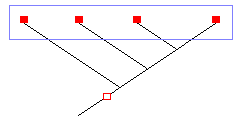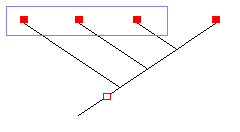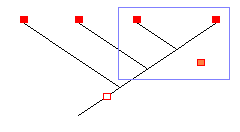
A: monophyletic group

B: paraphyletic group

C: polyphyletic group
 A: monophyletic group |
 B: paraphyletic group |
 C: polyphyletic group |
Monophyletic groups (Picture A):
contain all groups descendant from a common ancestor, defined by common newly acquired characters, which can be proven as homologies, so-called synapomorphies. Those groups are referred to as sister groups.
Systematic groups are called taxa (sg.: taxon), which is why giving scientific names to taxa in biology is called taxonomy.
Monophyletic taxa generally can be referred to as clades (hence the subject of cladistics), no matter what their status is according to the common systematics.
Paraphyletic groups (Picture B):
do contain only groups descending from one ancestral taxon and defined by synapomorphies, but not all sister groups.
Polyphyletic groups (Picture C):
apart from the sister groups also contain groups not descended from the specified ancestral taxon. Those have developed similar characters based on convergence, so-called analogies as opposed to homologies. An example would be all flying animals, or hard-shelled animals, such as snails, crabs and turtles.
In contrary to that symplesiomorphies define primitive characters, the possession of which several systematically higher groups and their descendent groups have in common..